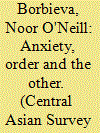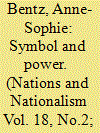| Srl | Item |
| 1 |
ID:
126041


|
|
|
|
|
| Publication |
2013.
|
| Summary/Abstract |
Neither well-being nor suffering can be understood without understanding how the two experiences are related. In this paper, the author focuses on the experiences of well-being and suffering in everyday, mundane contexts, such as food preparation, cleaning and hospitality. Data presented are drawn from fieldwork conducted among ethnic Kyrgyz and Uzbeks in southern Kyrgyzstan, shortly after independence. The author discusses how the experiences of well-being and suffering are informed by symbolic systems that are linked to religious beliefs. This examination contributes to an understanding of the power of religious symbols, arguing that the expectations of well-being or suffering make systems of religious symbols more compelling.
|
|
|
|
|
|
|
|
|
|
|
|
|
|
|
|
| 2 |
ID:
111864


|
|
|
|
|
| Publication |
2012.
|
| Summary/Abstract |
This article originated in a brief but inspiring analysis by Margaret Nowak. Nowak used Sherry Ortner's concept of 'summarising symbol' to imply that, much the same way as the American flag was the epitome of the United States to each and every American, the Dalai Lama encompasses everything Tibetan to the Tibetan people. What does this comparison say about the Dalai Lama? I examine the relationship between symbol, power and charisma with Tenzin Gyatso, the current Dalai Lama, as a case in point. With exile, there has been a shift in the symbolic importance of the Dalai Lama, both as a man and as an institution, from a symbol of Tibet and Tibetan Buddhism to a symbol of the Tibetan cause and, more generally, to a symbol of Buddhism in the world. These changes have given Tenzin Gyatso a new authority in the Tibetan community: he is now the unique and unquestioned leader of the Tibetan cause in the world. I discuss the problems that occur when a symbol is also a man and a leader, as well as the solutions proposed, at a moment when the Tibetan community in exile is experiencing democratisation.
|
|
|
|
|
|
|
|
|
|
|
|
|
|
|
|